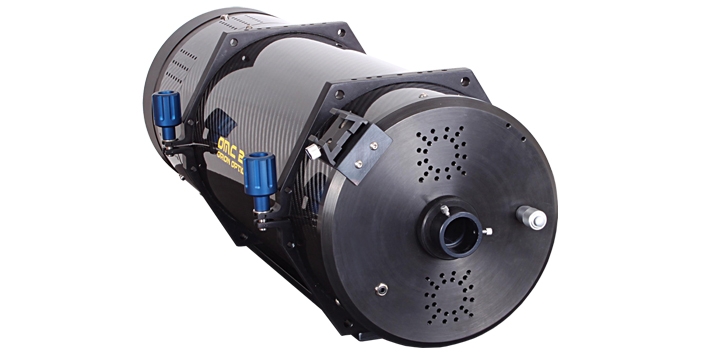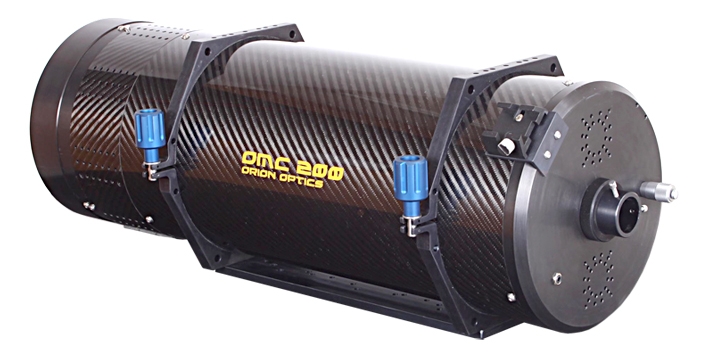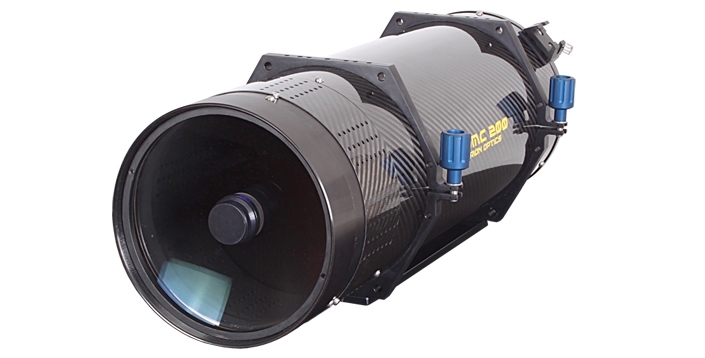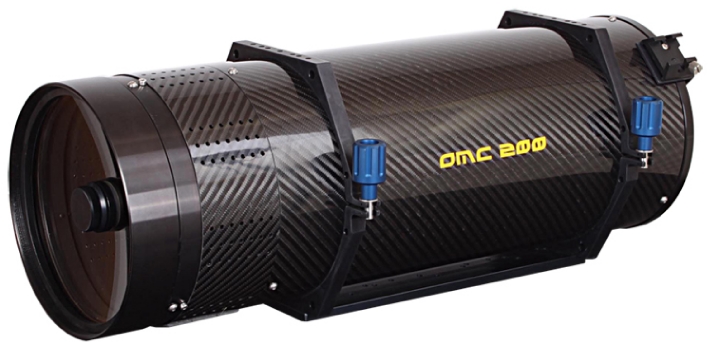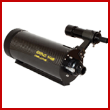|
In the late 90’s we brought out a bigger brother to the very successful OMC140 Maksutov Cassegrain, the OMC200. This telescope was designed purely for planetary and lunar observing.
It was a typical planetary telescope designed around a design Harrie Rutten devised, the Rumak.
The Rumak uses a separate secondary mirror, this enables a greater amount of flexibility in the design, it also allows a major feature of any Maksutov to be ‘miniaturised’, the secondary mirror. Typical Maksutovs have secondary mirrors which vary in size from around 26% up to a rather large, 45%. The OMC200 has a 22% secondary mirror, 4.8% obstruction to the light path. What effect has this on the image quality? It enables a reflecting telescope to be as close as possible to a refractor’s performance in terms of MTF (modular Transfer Function) MTF is the data which determines how much low contrast detail can be seen in an image, e.g. faint bands on Jupiter. Telescopes with MTF curves which are less effective than the OMC200 reduce the amount of detail visible in an image.
What effect has this on the image quality? It enables a reflecting telescope to be as close as possible to a refractor’s performance in terms of MTF (modular Transfer Function) MTF is the data which determines how much low contrast detail can be seen in an image, e.g. faint bands on Jupiter. Telescopes with MTF curves which are less effective than the OMC200 reduce the amount of detail visible in an image.
MTF has nothing to do with PV wavefront accuracy, that can be measured on a Zygo for instance, MTF is far more difficult to measure but, the MTF plot of the OMC200 and the PV wavefront results guarantee you an incredible journey into the best planetary and lunar views you might possibly ever see in an Earth based telescope.
(see RMS Spot Radius vs Field Plot below)
Why did we stop making it then?
The corrector lens in an OMC200 has to be virtually flawless. The corrector glass we were buying initially when making the OMC200 fell into this category but, it later declined in quality and we had to discontinue production rather than send out any slightly below perfect telescopes. We have now received samples from a new supplier and have successfully put 5 pieces into work for customers. As a result of this we are now in a position to offer again this superb telescope.
![]()
User reviews OMC 200 f20
I I am using a 7” Mewlon, it never quite matches up to the APO like views, I have often pined for a bit more aperture in a small scope. Thanks to my friend I recently purchased an OMC200 and have been using it for two sessions this week.
What can I say about it? Simply put everyone should have one! In my last report I was actually using the scope at x400 in daylight on the moon. Well tonight it was x400 in the dark – the contrast is APO like – the detail is amazing. The craters are black and the high contrast allows the finest of details to be seen. Almost too much detail for me to sketch with my limited skills. I was so impressed I just had to stop racing along the terminator and concentrate on a small area.
On stars – tight and against a black background – wonderful. Superb diffraction rings when out of focus. Collimation is perfect despite its journey by road. There was me looking at a mag 12 double, at x 400. Colour in stars is much more obvious. Happily seeing colour in a mag 7 double, sep 1.6”, also in 8.5/8.9 double sep by 1.5”. I can now go hunting closer doubles and much fainter ones – joy oh joy – have to create new doubles lists to push this scope to the limits
Then I wandered through 9 open clusters in Auriga – delightful. Looked at M42, Beetlegeuse, Mu Ori and Rigel.
The finder scope is also excellent. The scope is out performing both the 7” Mewlon and the C9.25. Time to rationalise my scopes I think.
In the earlier hours I got out again this time for Jupiter watching. The air was so unsteady that it was not the best of times for putting the OMC through its paces. However despite the poor conditions I was getting a view that was as good as the 20” on its best nights and in fleeting moments I could see much more detail.
I also looked at the Leo Messier galaxies, again I felt the good contrast helped them stand out.
At this point I should exclaim “Wow, blown away” and no doubt a beginner would, but of course I knew the OMC would deliver. I knew I was using an instrument of quality. Hard to imagine a better scope for the aperture, overall size and weight. This is surely the scope that will see me out.
Fred
SEARCH
Back to previous page



Model Range
*The weights shown on each model refer to the standard optical tube with no additional equipment added.
Specification |
OMC200 |
Aperture |
200mm |
Primary Mirror |
210mm |
Secondary Mirror |
44mm |
Focusing Method |
100% zero image |
Mirror Coating |
Hilux on |
Tube Length |
600mm |
Tube Material |
Carbon Fibre |
Focal Length |
4000mm |
Focal Ratio |
f20 |
Tube Weight |
9kg |
Optical Back |
31.7mm |
Mount Fixing |
Dovetail of |
Wavefront Optics |
1/8PV |
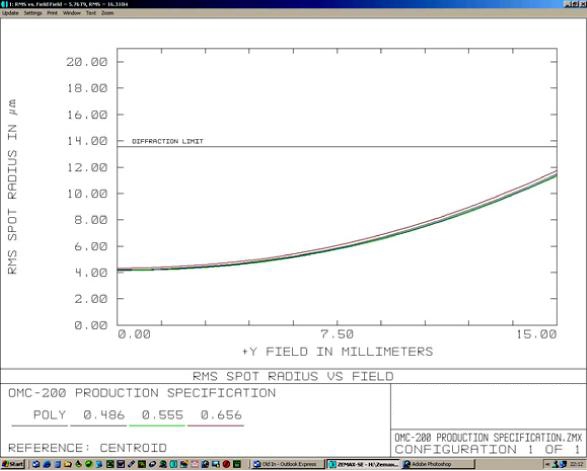
User review OMC 200 f20
I have used many quality telescopes in my years in astronomy: TMB 152 Refractor/Takahashi FS 152 /10" TEC Mak cass and many various designs but I must say the OMC 200 is one of the very best planetary/lunar telescopes I have ever used - the contrast needs to be seen to be believed!
The views of the moon/planets are jaw dropping. On one particular night I decided to set up the OMC up at the side of my TMB 6" refractor expecting the refractor to out perform the OMC 200 by quite a considerable margin but, to my surprise, the out performing was done by the OMC, the scope was showing detail on Jupiter that was stunning (that's not to say the views in the refractor were bad) it's just the detail seen in the OMC was that much better.
Tom Yates (England)
